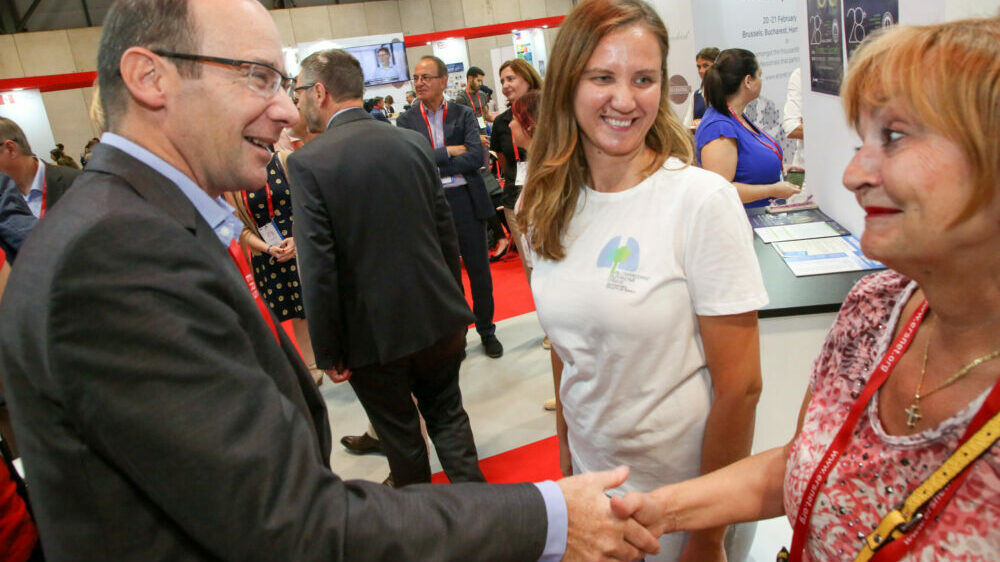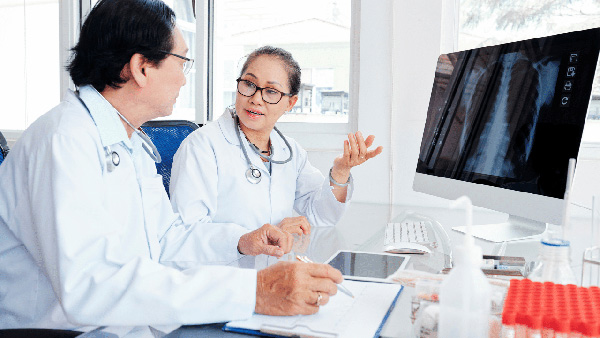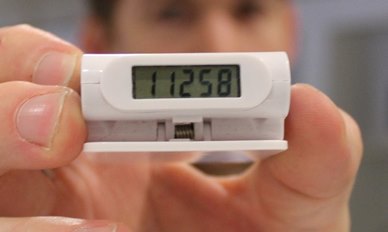For the duration of the ERS conference, Amsterdam was invited to think about the consequences of physical inactivity. Pedometers were given away to delegates to make them sensitive to their own activity level. Being active is important for all of us and in order to provide good advice one needs to be conscious of the concept. In that respect the #ERS10Ksteps campaign was surely a success. Step counts were buzzing among the 23,000 participants and many internal competitions or challenges were on-going. I won mine against Professor Stefano Aliberti, Head of Assembly 10. He probably had too many meetings on Sunday, the day of our challenge.
Time at conferences and just our daily life, is often too inactive. We feel important sitting for hours in meetings, trying to change our world, while harming our own health. Inactive time should be broken by physical activity bouts. Long meetings should have a mandatory activity break of 10 minutes. The European Respiratory Society, but also societies like the World Health Organization Health Enhancing Physical Activity (WHO HEPA) network, or the European Society of Cardiology can advocate for this and can try to lead by example. Knowledge of appropriate physical activity levels is low among healthcare providers.
The benchmark for smoking is an easy one to remember… ZERO cigarettes…The healthy levels of physical activity are more difficult to get a grip on. 30 minutes of moderate-intense activity (activity that increases your breathing and may make patients somewhat out of breath) on five days per week is typically advised.
A more practical way of monitoring this is to use the 10,000 steps benchmark for healthy people. A normal working day in a sedentary job (also mine…) accumulates around 7,000 steps. When you walk, your walking pace is around 100 steps per minute. Thirty minutes equals roughly 3,000 steps. 7,000 + 3,000 and you have the ‘magic’ 10K steps. There is slightly more science behind it, luckily, but it is an easy benchmark to remember and it is easy to measure with unsophisticated step counters.
For patients it becomes slightly more complex. If they average 7,000 steps a day, the patient has an inactive lifestyle. When the figure is less than 5,000 steps per day as an average over a few days, this is frank sedentarism.
The importance of physical activity as a biomarker for ‘health’ is being picked up and it is exciting to see the efforts of our Society and the European Lung Foundation with the Healthy Lungs for Life campaign. Equally important is the publication of an ERS statement around physical activity in COPD by Dr Watz and his team of experts in 2014. In 2009 the first Innovative Medicines Initiative (IMI) project in COPD was launched around the topic of developing tools to measure physical activity and develop interventions that may help clinicians to do so.
The ‘PROactive’ COPD project delivered two patient reported outcomes, developed a telecoaching application that turned out to be extremely successful to stimulate physical activity and, perhaps the most important outcome; engaged the pharmaceutical industry in the physical activity problem and its solutions. Treatment to enhance physical activity does not come in a puff… Isn’t it nice to see that pharma companies are nowadays setting up studies that try to embed pharmacotherapy in optimised physical activity management?
The PROactive projected has surely contributed to get the interest of pharmaceutical companies in this therapeutic dilemma. In addition good guidance is available on to how to organise pulmonary rehabilitation from the statement of the American Thoracic Society and the European Respiratory Society on pulmonary rehabilitation. This statement will very soon be flanked by a policy statement written by Drs Rochester and Vogiatzis, which asks the question: why does a very effective therapy, such as rehabilitation, have such poor uptake?
There are too few centres of excellence available in most countries. In my opinion, pulmonary rehabilitation should be an affordable treatment option for all patients. The indication for further rehabilitation assessment should be known to all chest physicians. In such a landscape the more potent pharmacotherapy that is (being) developed will be able to see its full potential.
Rest assured, it will be a long and windy road to full deployment of pulmonary rehabilitation and physical activity programs. Resistance can be expected from payers and from patients. With better public knowledge of the benefits of rehabilitation and physical activity that resistance can perhaps be reduced. Programs should perhaps also be offered taking into account patient preferences. That is our –my- responsibility.
One golden tip in the present state of affairs: ask patients to use a pedometer that picks up slow walking and provide them with a step count goal they see feasible to achieve. If you do not have the time or expertise to do so, perhaps look for a physiotherapist or a rehabilitation program around your practice that can help (the ERS directory of group 9.2 or 1.2 may be helpful). Just like you would refer for external smoking cessation counseling if you lack time or expertise to follow-up on it. Make sure you ask your patient at every encounter about their physical activity levels. I have stolen the phrase from Dr Zu Wallack (Conneticut, US): stop asking your patients ‘How do you do?’… Instead ask them ‘What do you do’? If you want to be more precise… you can use good and affordable activity monitors.
Knowledge on physical activity and exercise should be embedded in a personal health culture and hygiene. Practice what you preach… or at least have personal knowledge on what you preach. In that respect the ‘Take the active option’ campaign is surely an important step. There are many steps to follow! I think I may have been convinced that it is also for me ‘time to take the active option’.
Read on:
www.proactivecopd.com
Watz et al ERS statement on physical activity in COPD Eur Respir J 2014
Spruit et al ATS and ERS statement on pulmonary rehabilitation Am J Respir Crit Care Med 2013
Troosters et al Improving physical activity in COPD: towards a new paradigm. Respir Res 2013
Upcoming: Troosters T. Should European Respiratory Society meetings come with a health warning? Breathe 2015 DOI: 10.1183/20734735.009615.
An example of the lack of ‘penetration’ of Pulmonay rehabilitation for patients with COPD:
I was invited to speak in a seminar sponsored by a pharmaceutical company in a European country. With other speakers, we discussed in much detail the importance of physical activity in lung disease and muscular dysfunction. The next morning three case reports were presented extensively.
The questions asked to and by the audience were all geared to pharmacologic treatment. ‘Yes’ or ‘No’ to inhaled corticosteroids, which long acting bronchodilator, other available therapies, ‘Azythromycine’ as long term treatment etc. Discussion was interesting and took a fair amount of time.
At the end of the discussion – I was a member of the audience then – I asked why pulmonary rehabilitation was not considered as a treatment option. One of the patients had clear symptoms upon exercise, suffered from osteoporosis and had cachexia, based on BMI, another patient had suffered from repeated exacerbations. For the third patient I could not really judge on the indication for rehabilitation based on the presented data.
Exercise training and pulmonary rehabilitation were not mentioned once in the whole discussion. The silence after asking the question was a bit annoying. It turned out that rehabilitation was not available but sometimes a nurse was asked to do some exercises. It sounded to me like offering Salbutamol to a patients in GOLD stage IV. This sets the scene for the ERS-ATS policy statement on pulmonary rehabilitation.






